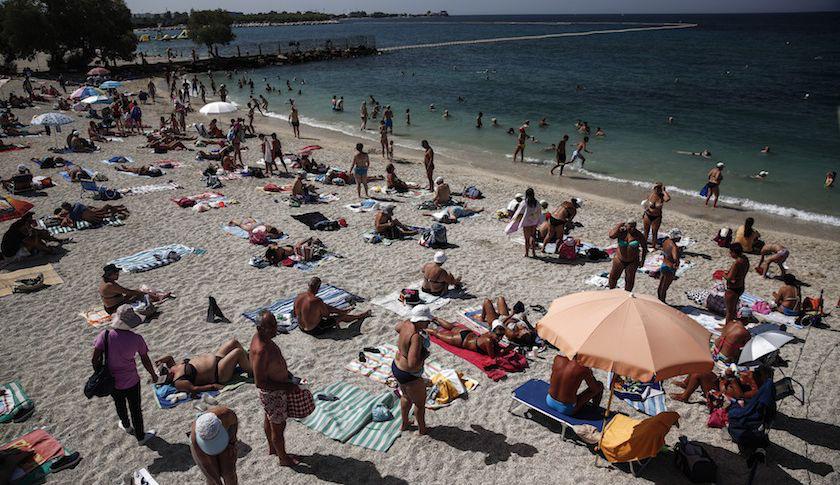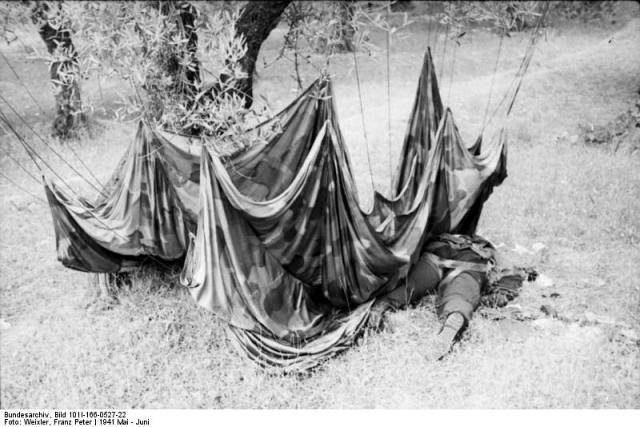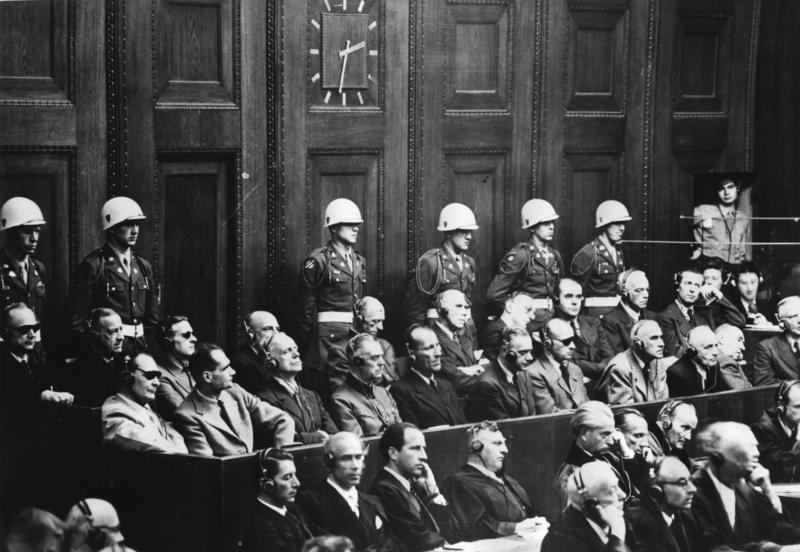.
![File:Bundesarchiv Bild 183-V01732, Nürnberger Prozess, Angeklagte.jpg]()
Hermann Göring (in dark glasses, leaning on the dock), at the Nuremberg trials, 1945: photographer unknown (Deutsches Bundesarchiv)
![1941, Crète, Kondomari, le 2 juin - 02/23 | by ww2gallery]()
Kondomari, Crete: photo by Franz Peter Weixler, 2 June 1941 (Deutsches Bundesarchiv; image by ww2gallery, 4 January 2015)
I shall now describe the manner in which I was enabled to take the photos mentioned above.
![1941, Crète, Kondomari, le 2 juin - 08/23 | by ww2gallery]()
Kondomari, Crete: photo by Franz Peter Weixler, 2 June 1941 (Deutsches Bundesarchiv; image by ww2gallery, 4 January 2015)
On June 1 or 2, 1941, I was in my billet in the capital of Crete, Chania, when a young officer told me that that afternoon I would see something very interesting.
![]()
![]()
![1941, Crète, Kondomari, le 2 juin - 17/23 | by ww2gallery]()
Kondomari, Crete: photo by Franz Peter Weixler, 2 June 1941 (Deutsches Bundesarchiv; image by ww2gallery, 4 January 2015)
![1941, Crète, Kondomari, le 2 juin - 18/23 | by ww2gallery]()
Kondomari, Crete: photo by Franz Peter Weixler, 2 June 1941 (Deutsches Bundesarchiv; image by ww2gallery, 4 January 2015)
I then went to see Major STENZLER who told me that a delegation of the German Foreign Office had left Berlin the day before in order to make an investigation concerning the alleged massacring of German soldiers.
![]()
![1941, Crète, Kondomari, le 2 juin - 15/23 | by ww2gallery]()
Kondomari, Crete: photo by Franz Peter Weixler, 2 June 1941 (Deutsches Bundesarchiv; image by ww2gallery, 4 January 2015)
I reminded the major that we had seen innumerable half-decayed comrades, but that we had never seen a single murder or massacre, and [said] that I would consider it outright murder to execute Goering's order.
![1941, Crète, Kondomari, le 2 juin - 16/23 | by ww2gallery]()
Kondomari, Crete: photo by Franz Peter Weixler, 2 June 1941 (Deutsches Bundesarchiv; image by ww2gallery, 4 January 2015)
I implored Major Stenzler not to send out the punitive expedition. He told me that this was none of my business.
![]()
I went to see Lieutenant Trebes, who was just making a speech to a group of about 30 men, to the effect that "the action would have to be carried through as quickly as possible, as a reprisal for our comrades who had been murdered".
![]()
The punitive expedition consisted of Trebes, another lieutenant, an interpreter, two sergeants and about twenty five parachutists of the Second Battalion.
![1941, Crète, Kondomari, le 2 juin - 09/23 | by ww2gallery]()
Kondomari, Crete: photo by Franz Peter Weixler, 2 June 1941 (Deutsches Bundesarchiv; image by ww2gallery, 4 January 2015)
As a photographer assigned to my division I was permitted to accompany this Kommando [unit].
![1941, Crète, Kondomari, le 2 juin - 06/23 | by ww2gallery]()
Kondomari, Crete: photo by Franz Peter Weixler, 2 June 1941 (Deutsches Bundesarchiv; image by ww2gallery, 4 January 2015)
Near the village of Malemes, we stopped and Trebes showed us the corpses of several soldiers, obviously in the process of decay. He incited the men against the civilian population.
![]()
![Kreta, Kondomari, Erschieflung von Zivilisten]()
Kondomari, Crete: photo by Franz Peter Weixler, 2 June 1941 (Deutsches Bundesarchiv; image by The Pappas Post 28 May 2014)
The men got off, and ran into the few houses of the little community.
![1941, Crète, Kondomari, le 2 juin - 13/23 | by ww2gallery]()
Kondomari, Crete: photo by Franz Peter Weixler, 2 June 1941 (Deutsches Bundesarchiv; image by ww2gallery, 4 January 2015)
They got all men, women, and children onto the little square.
![1941, Crète, Kondomari, le 2 juin - 14/23 | by ww2gallery]()
Kondomari, Crete: photo by Franz Peter Weixler, 2 June 1941 (Deutsches Bundesarchiv; image by ww2gallery, 4 January 2015)
A German soldier brought out the coat of a parachutist which he had picked up in one of the houses, and which had a bullet hole in the back.
![1941, Crète, Kondomari, le 2 juin - 07/23 | by ww2gallery]()
Kondomari, Crete: photo by Franz Peter Weixler, 2 June 1941 (Deutsches Bundesarchiv; image by ww2gallery, 4 January 2015)
Trebes had the house burned down immediately.
![1941, Crète, Kondomari, le 2 juin - 11/23 | by ww2gallery]()
Kondomari, Crete: photo by Franz Peter Weixler, 2 June 1941 (Deutsches Bundesarchiv; image by ww2gallery, 4 January 2015)
One man admitted having killed a German soldier, but it was not possible to convict any of the others of any crimes or plundering, and I therefore asked Trebes to stop the contemplated action and give us orders to return, taking with us only the one man.
![1941, Crète, Kondomari, le 2 juin - 12/23 | by ww2gallery]()
Kondomari, Crete: photo by Franz Peter Weixler, 2 June 1941 (Deutsches Bundesarchiv; image by ww2gallery, 4 January 2015)
Trebes however gave orders to separate the men from the women and children; then he had the interpreter tell the women that all of the men would be shot because of having murdered German soldiers, and that the corpses would have to be interred within two hours.
![1941, Crète, Kondomari, le 2 juin - 10/23 | by ww2gallery]()
Kondomari, Crete: photo by Franz Peter Weixler, 2 June 1941 (Deutsches Bundesarchiv; image by ww2gallery, 4 January 2015)
When Trebes turned his back for a few moments, I made it possible for nine men to get away.
![1941, Crète, Kondomari, le 2 juin - 19/23 | by ww2gallery]()
Kondomari, Crete: photo by Franz Peter Weixler, 2 June 1941 (Deutsches Bundesarchiv; image by ww2gallery, 4 January 2015)
Trebes had the men form a half circle, gave the order to fire, and after about fifteen seconds, everything was over.
![1941, Crète, Kondomari, le 2 juin - 20/23 | by ww2gallery]()
Kondomari, Crete: photo by Franz Peter Weixler, 2 June 1941 (Deutsches Bundesarchiv; image by ww2gallery, 4 January 2015)
![1941, Crète, Kondomari, le 2 juin - 21/23 | by ww2gallery]()
Kondomari, Crete: photo by Franz Peter Weixler, 2 June 1941 (Deutsches Bundesarchiv; image by ww2gallery, 4 January 2015)
![Kondomari Creta 28 | by www.historiassegundaguerramundial.com]()
Kondomari, Crete: photo by Franz Peter Weixler, 2 June 1941 (Deutsches Bundesarchiv; image by Historia Segunda Guerra Mundial, 30 November 2013)
![crete1013822_10203169461591752_3634255859570121124_n | by sahill1968]()
Kondomari, Crete: photo by Franz Peter Weixler, 2 June 1941 (Deutsches Bundesarchiv; image by Steve Hill, 18 May 2014)
![crete1907641_10203169462311770_2385062965952942583_n | by sahill1968]()
Kondomari, Crete: photo by Franz Peter Weixler, 2 June 1941 (Deutsches Bundesarchiv; image by Steve Hill, 18 May 2014)
I asked Trebes, who was quite pale, whether he realized what he had done, and he replied that he had only executed the order of Hermann Goering, and avenged his dead comrades.
![File:Nuremberg-1-.jpg]()
Defendants in the dock, Nuremberg trials, 1945-1946: front row, left to right, Hermann Göring, Rudolf Hess, Joachim von Ribbentrop, Wilhelm Keitel; in second row, left to right, Karl Dönitz, Erich Raeder, Baldur von Schirach, Fritz Sauckel: photo by Office of the U.S. Chief of Counsel for the Prosecution of Axis Criminality/Still Picture Records LICON, Special Media Archives Services Division (NWCS-S) (National Archives and Records Administration)
A few days later he received the Knights Cross from Goering for his “braveness” in Crete.
![final-shot]()
Kondomari, Crete: photo by Franz Peter Weixler, 2 June 1941 (Deutsches Bundesarchiv; image by The Pappas Post 28 May 2014)
In spite of the fact that the original film was taken away from me by my superiors, and that I had to sign a declaration to the effect that I had no copies, it was possible for me to save copies and use them later in activity against Hitler and his regime.
Rebecca West: Göring at Nuremberg
![File:Goering on trial (color).jpg]()
German Reichsmarschall, Commander of the Luftwaffe Hermann Göring (1893-1946) during cross examination at his trial for war crimes in Room 600 at the Palace of Justice during the International Military Tribunal (IMT), Nuremberg, Germany, March 1946: photo by Raymond D'Addario, 3264th Signal Photo Service Company, US Army (National Archives, courtesy of USHMM Photo Archives)
Rebecca West: from Greenhouse with Cyclamens (I), 1946, in A Train of Powder, 1955
A man walks past graffiti painted on a closed shop in the Monastiraki area in central Athens: photo by Christian Hartmann/Reuters via FT Photo Diary, 7 July 2015
#Greece Travel Bookings From #Germany Collapsed 39%, Amadeus Says (via Bloomberg Business): image via Zoe Schneeweiss @ZSchneeweiss, 8 July 2015
Ouch! Polish RightWing MEP @mikkenewsjust called for a military coup in #Greece: image via Julian Röpcke @Julian Roepcke, 8 July 2015
George Seferis: Postscript
But their eyes are all white, without lashes
and their arms thin as reeds.
Lord, not with these people. I've known
the voices of children at dawn
rushing down green slopes
happy as bees, happy as butterflies
with so many colours.
Lord, not with these people, their voices
don't even leave their mouths --
they stay glued to their yellow teeth.
Yours is the sea and the wind
with a star hung in the firmament.
Lord, they don't know that we are
what we are able to be
healing our wounds with herbs
found on the green slopes,
these slopes nearby, not any others;
that we breathe as we are able to breathe
with a little prayer each dawn
that reaches the shore by crossing
the chasms of memory --
Lord, not with these people. Let your will be done in another way.
But their eyes are all white, without lashes
and their arms thin as reeds.
Lord, not with these people. I've known
the voices of children at dawn
rushing down green slopes
happy as bees, happy as butterflies
with so many colours.
Lord, not with these people, their voices
don't even leave their mouths --
they stay glued to their yellow teeth.
Yours is the sea and the wind
with a star hung in the firmament.
Lord, they don't know that we are
what we are able to be
healing our wounds with herbs
found on the green slopes,
these slopes nearby, not any others;
that we breathe as we are able to breathe
with a little prayer each dawn
that reaches the shore by crossing
the chasms of memory --
Lord, not with these people. Let your will be done in another way.
..............................
George Seferis (1900-1971): Postscript, from Logbook II (Alexandria, 1944), in Collected Poems, translated from the Greek by Edmund Keeley and Philip Sherrard, 1991
George Seferis (1900-1971): Postscript, from Logbook II (Alexandria, 1944), in Collected Poems, translated from the Greek by Edmund Keeley and Philip Sherrard, 1991
The day the Germans came to Kondomari
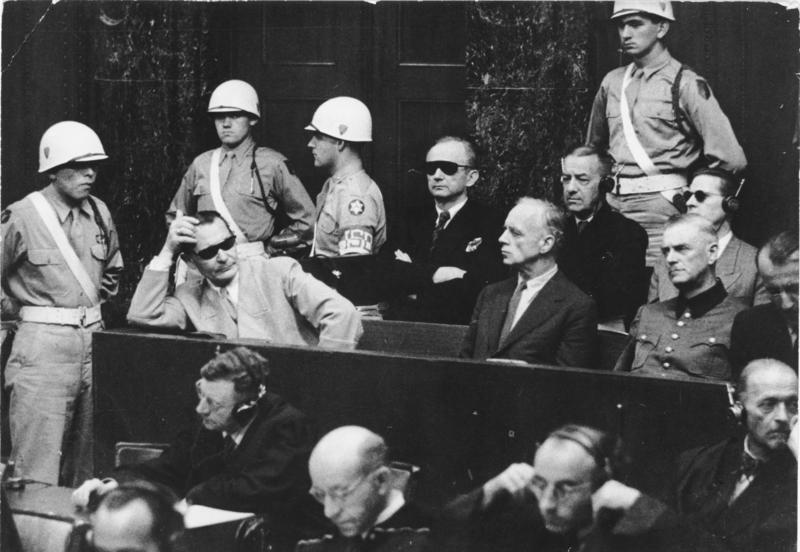
Hermann Göring (in dark glasses, leaning on the dock), at the Nuremberg trials, 1945: photographer unknown (Deutsches Bundesarchiv)
Source: Information supplied by Franz Peter WEIXLER
Krailling, near Munich, 11 November 1945
TRANSLATION BY Herma Plummer
Krailling, near Munich, 11 November 1945
TRANSLATION BY Herma Plummer
Goering Case
In connection with the Nurnberg trials against Goering et al. I would like to make the following statement with the express authorization that it may be used in the trial.
![1941, Crète, Kondomari, le 2 juin - 01/23 | by ww2gallery]()
Kondomari, Crete: photo by Franz Peter Weixler, 2 June 1941 (Deutsches Bundesarchiv; image by ww2gallery, 4 January 2015)
I was a prisoner of the Gestapo from January 16, 1944 to April 1945.
Kondomari, Crete: photo by Franz Peter Weixler, 2 June 1941 (Deutsches Bundesarchiv; image by ww2gallery, 4 January 2015)

Kondomari, Crete: photo by Franz Peter Weixler, 2 June 1941 (Deutsches Bundesarchiv; image by ww2gallery, 4 January 2015)
I had been indicted for treason before the People's Court, and the only reason I was not executed was the fact that my files were destroyed once in Berlin, and once at the Gestapo office in Nurnberg.
![1941, Crète, Kondomari, le 2 juin - 03/23 | by ww2gallery]()
Kondomari, Crete: photo by Franz Peter Weixler, 2 June 1941 (Deutsches Bundesarchiv; image by ww2gallery, 4 January 2015)

Kondomari, Crete: photo by Franz Peter Weixler, 2 June 1941 (Deutsches Bundesarchiv; image by ww2gallery, 4 January 2015)
One of the reasons for my indictment was the fact that I had told friends the truth about the parachute enterprise in Crete in May 1941, and also the fact that I had taken pictures there.
I am attaching an "order" of the German Army, which I appropriated and kept, issued by the divisional staff of the Parachute Division, commanded by General STUDENT.
![1941, Crète, Kondomari, le 2 juin - 05/23 | by ww2gallery]()
Kondomari, Crete: photo by Franz Peter Weixler, 2 June 1941 (Deutsches Bundesarchiv; image by ww2gallery, 4 January 2015)

Kondomari, Crete: photo by Franz Peter Weixler, 2 June 1941 (Deutsches Bundesarchiv; image by ww2gallery, 4 January 2015)
I shall now describe the manner in which I was enabled to take the photos mentioned above.

Kondomari, Crete: photo by Franz Peter Weixler, 2 June 1941 (Deutsches Bundesarchiv; image by ww2gallery, 4 January 2015)
On June 1 or 2, 1941, I was in my billet in the capital of Crete, Chania, when a young officer told me that that afternoon I would see something very interesting.
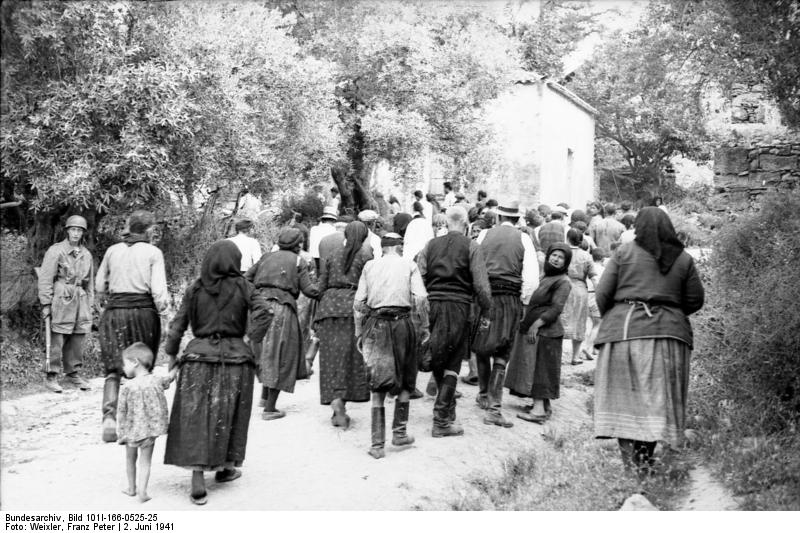
Kondomari, Crete: photo by Franz Peter Weixler, 2 June 1941 (Deutsches Bundesarchiv)
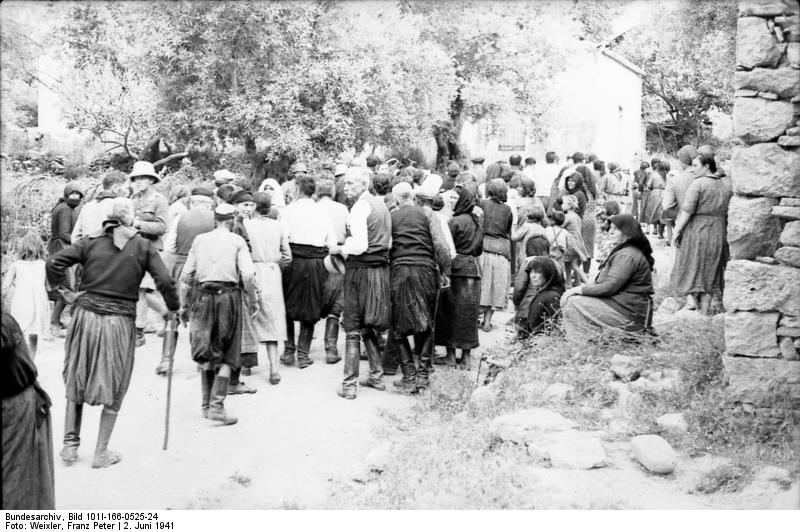
Kondomari, Crete: photo by Franz Peter Weixler, 2 June 1941 (Deutsches Bundesarchiv)
In answer to my question he told me that a punitive expedition would be sent against several villages since the corpses of parachutists, massacred and plundered, had been found.

Kondomari, Crete: photo by Franz Peter Weixler, 2 June 1941 (Deutsches Bundesarchiv; image by ww2gallery, 4 January 2015)
The supreme command of the Luftwaffe had been informed of this several days before, and an order had been received from Goering according to which 'the sharpest measures', i.e. the shooting of the male population between 18 and 50 years of age, was to take place.

Kondomari, Crete: photo by Franz Peter Weixler, 2 June 1941 (Deutsches Bundesarchiv; image by ww2gallery, 4 January 2015)
I told the young officer and Captain GERICKE that I had never seen a single massacred parachutist, but had seen dozens of dead comrades whose faces had been partially destroyed because of the tropical heat.
I then went to see Major STENZLER who told me that a delegation of the German Foreign Office had left Berlin the day before in order to make an investigation concerning the alleged massacring of German soldiers.
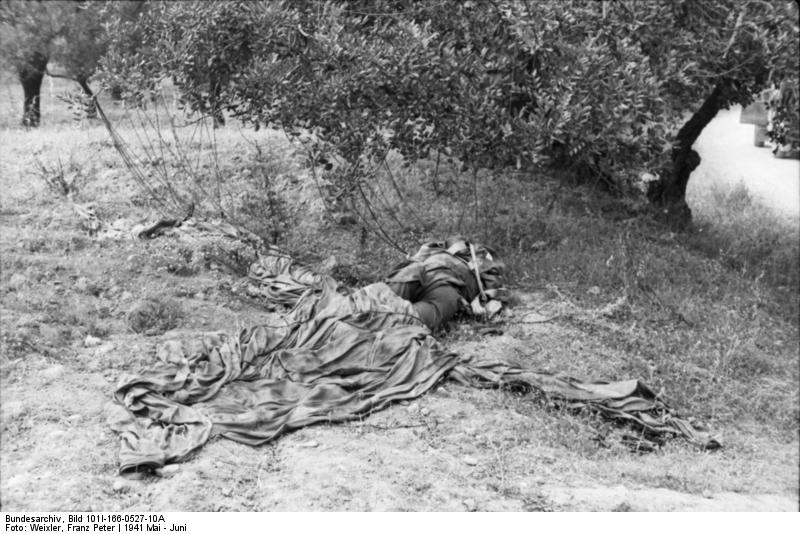
Fallen German parachutist, Crete: photo by Franz Peter Weixler, May/June 1941 (Deutsches Bundesarchiv; image by Historia Segunda Guerra Mundial, 4 April 2015)
I told Stenzler that during the first days of the fighting I had seen vultures pick on the corpses of our comrades.

Kondomari, Crete: photo by Franz Peter Weixler, 2 June 1941 (Deutsches Bundesarchiv; image by ww2gallery, 4 January 2015)

Kondomari, Crete: photo by Franz Peter Weixler, 2 June 1941 (Deutsches Bundesarchiv; image by ww2gallery, 4 January 2015)
I implored Major Stenzler not to send out the punitive expedition. He told me that this was none of my business.
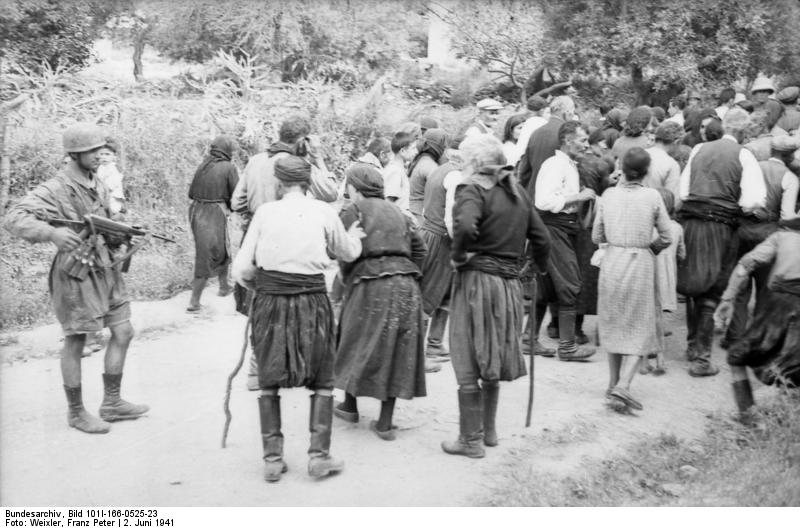
Kondomari, Crete: photo by Franz Peter Weixler, 2 June 1941 (Deutsches Bundesarchiv)
I went to see Lieutenant Trebes, who was just making a speech to a group of about 30 men, to the effect that "the action would have to be carried through as quickly as possible, as a reprisal for our comrades who had been murdered".

Oberleutnant Horst Trebes (right) at the ceremony to receive his decoration for 'valor' in Crete: photo by Franz Peter Weixler, 9 June 1941 (Deutsches Bundesarchiv)

Kondomari, Crete: photo by Franz Peter Weixler, 2 June 1941 (Deutsches Bundesarchiv; image by ww2gallery, 4 January 2015)
As a photographer assigned to my division I was permitted to accompany this Kommando [unit].

Kondomari, Crete: photo by Franz Peter Weixler, 2 June 1941 (Deutsches Bundesarchiv; image by ww2gallery, 4 January 2015)
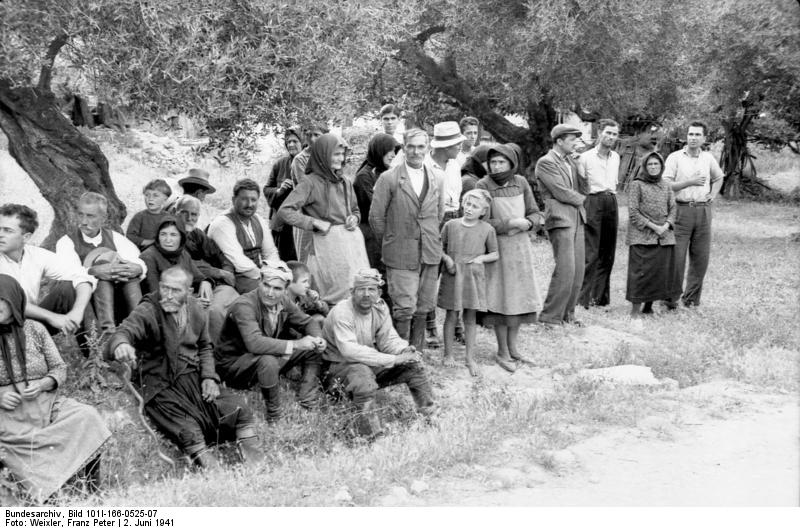
Kondomari, Crete: photo by Franz Peter Weixler, 2 June 1941 (Deutsches Bundesarchiv)
We continued our drive to the village of Kondomari.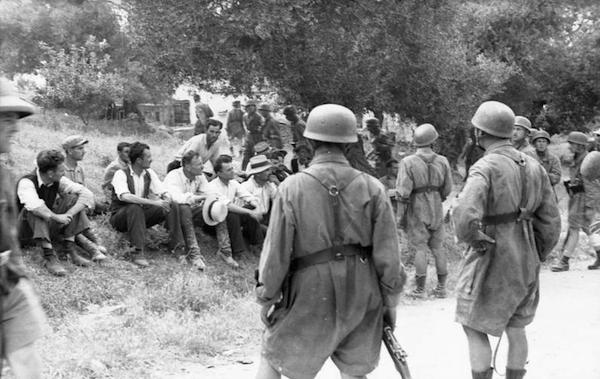
Kondomari, Crete: photo by Franz Peter Weixler, 2 June 1941 (Deutsches Bundesarchiv; image by The Pappas Post 28 May 2014)
The men got off, and ran into the few houses of the little community.

Kondomari, Crete: photo by Franz Peter Weixler, 2 June 1941 (Deutsches Bundesarchiv; image by ww2gallery, 4 January 2015)
They got all men, women, and children onto the little square.

Kondomari, Crete: photo by Franz Peter Weixler, 2 June 1941 (Deutsches Bundesarchiv; image by ww2gallery, 4 January 2015)

Kondomari, Crete: photo by Franz Peter Weixler, 2 June 1941 (Deutsches Bundesarchiv; image by ww2gallery, 4 January 2015)

Kondomari, Crete: photo by Franz Peter Weixler, 2 June 1941 (Deutsches Bundesarchiv; image by ww2gallery, 4 January 2015)

Kondomari, Crete: photo by Franz Peter Weixler, 2 June 1941 (Deutsches Bundesarchiv; image by ww2gallery, 4 January 2015)

Kondomari, Crete: photo by Franz Peter Weixler, 2 June 1941 (Deutsches Bundesarchiv; image by ww2gallery, 4 January 2015)

Kondomari, Crete: photo by Franz Peter Weixler, 2 June 1941 (Deutsches Bundesarchiv; image by ww2gallery, 4 January 2015)
Trebes had the men form a half circle, gave the order to fire, and after about fifteen seconds, everything was over.

Kondomari, Crete: photo by Franz Peter Weixler, 2 June 1941 (Deutsches Bundesarchiv; image by ww2gallery, 4 January 2015)

Kondomari, Crete: photo by Franz Peter Weixler, 2 June 1941 (Deutsches Bundesarchiv; image by ww2gallery, 4 January 2015)
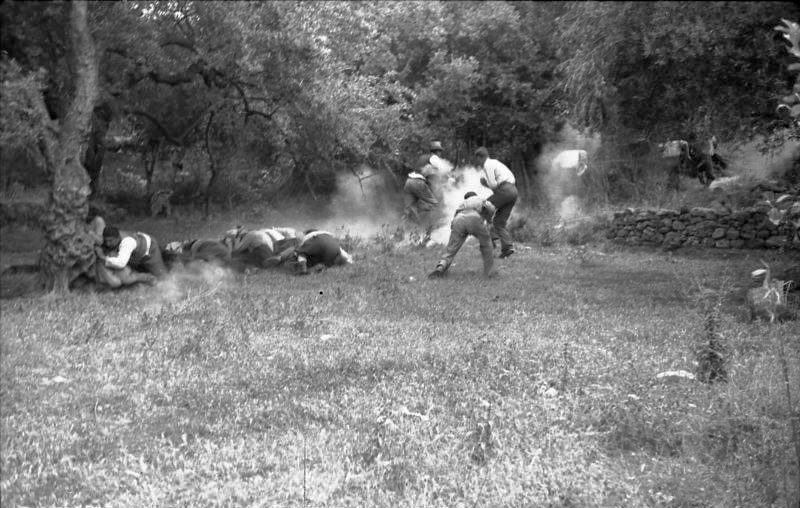
Kondomari, Crete: photo by Franz Peter Weixler, 2 June 1941 (Deutsches Bundesarchiv; image by Historia Segunda Guerra Mundial, 30 November 2013)
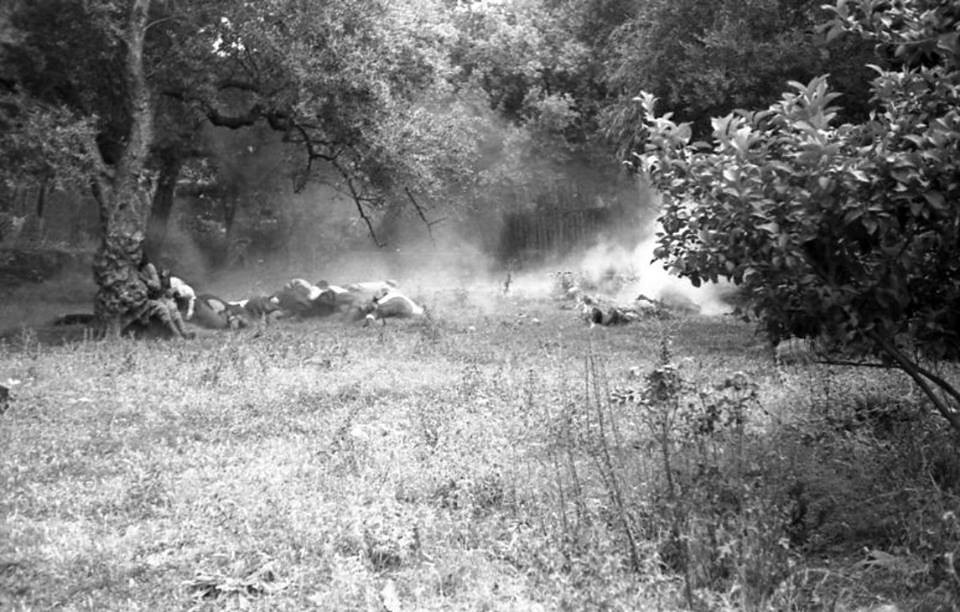
Kondomari, Crete: photo by Franz Peter Weixler, 2 June 1941 (Deutsches Bundesarchiv; image by Steve Hill, 18 May 2014)
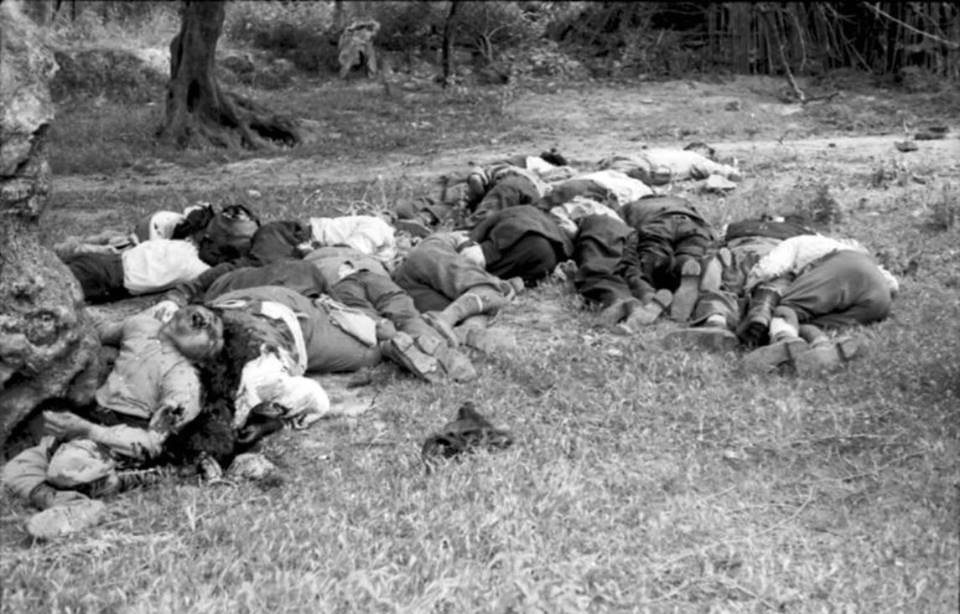
Kondomari, Crete: photo by Franz Peter Weixler, 2 June 1941 (Deutsches Bundesarchiv; image by Steve Hill, 18 May 2014)

Defendants in the dock, Nuremberg trials, 1945-1946: front row, left to right, Hermann Göring, Rudolf Hess, Joachim von Ribbentrop, Wilhelm Keitel; in second row, left to right, Karl Dönitz, Erich Raeder, Baldur von Schirach, Fritz Sauckel: photo by Office of the U.S. Chief of Counsel for the Prosecution of Axis Criminality/Still Picture Records LICON, Special Media Archives Services Division (NWCS-S) (National Archives and Records Administration)
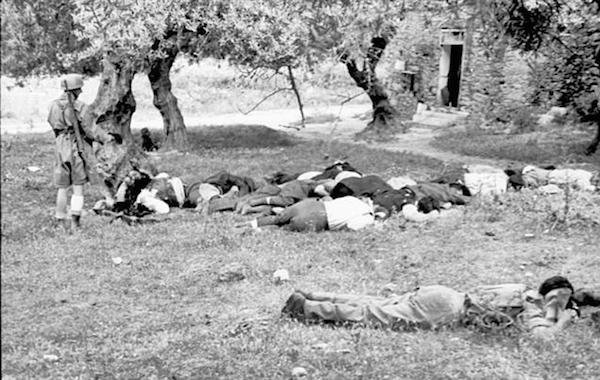
Kondomari, Crete: photo by Franz Peter Weixler, 2 June 1941 (Deutsches Bundesarchiv; image by The Pappas Post 28 May 2014)
It was possible for me to get the negatives of my photos to a friend in Athens, who saved copies.
Hermann Göring during cross-examination, Nuremberg trials, March 1946: photographer unknown (USHMM Photo Archives, courtesy of National Archives and Records Administration)
Franz Peter WEIXLER
Rebecca West: Göring at Nuremberg

German Reichsmarschall, Commander of the Luftwaffe Hermann Göring (1893-1946) during cross examination at his trial for war crimes in Room 600 at the Palace of Justice during the International Military Tribunal (IMT), Nuremberg, Germany, March 1946: photo by Raymond D'Addario, 3264th Signal Photo Service Company, US Army (National Archives, courtesy of USHMM Photo Archives)
And though one had read surprising news of Göring for years, he still surprised. He was so very soft. Sometimes he wore a German Air Force uniform, and sometimes a light beach suit in the worst of playful taste, and both hung loosely on him, giving him an air of pregnancy. He had thick brown young hair, the coarse bright skin of an actor who has used grease paint for decades, and the preternaturally deep wrinkles of the drug addict. It added up to something like the head of a ventriloquist’s dummy. He looked infinitely corrupt, and acted naively. When the other defendants’ lawyers came to the door to receive instructions, he often intervened and insisted on instructing them himself, in spite of the evident fury of the defendants, which, indeed, must have been poignant, since most of them might well have felt that, had it not been for him, they never would have had to employ these lawyers at all. One of these lawyers was a tiny little man of very Jewish appearance, and when he stood in front of the dock, his head hardly reaching to the top of it, and flapped his gown in annoyance because Göring’s smiling wooden mask was bearing down between him and his client, it was as if a ventriloquist had staged a quarrel between two dummies.
View of the defendants in the dock at the International Military Tribunal trial of war criminals at Nuremberg [Göring, with US Army blanket draped over his lap, at far left in front row]: photographer unknown, November 1945 (National Archives, courtesy of USHMM Photo Archives)
Something had happened to the architecture of the court which might happen in a dream. It had always appeared that the panelled wall behind the dock was solid. But one of the panels was really a door. It opened, and the defendants came out one by one to stand between two guards and hear what they had earned. Göring, in his loose suit, which through the months had grown looser and looser, came through that door and looked surprised, like a man in pajamas who opens a door our of his hotel room in the belief that it leads to his bathroom and finds that he has walked out into a public room. Earphones were handed him by the guard and he put them on, but at once made a gesture to show that they were not carrying the sound. They had had to put on a longer flex to reach from the ground to the ear of a standing man, and the adjustment had been faulty. His guards knelt down and worked on them. On the faces of all the judges was written the thought, "Yes, this is a nightmare. This failure of the earphones proves it," and it was written on his face too. But he bent down and spoke to them and helped with the repair. This man of fifty-three could see the fine wires without spectacles. When the earphones were repaired he put them on with a steady hand and learned that this was not a nightmare, he was not dreaming. He took them off with something like a kingly gesture and went out, renouncing the multitudinous words and gestures that must have occurred to him at this moment. He was an inventive man and could not have had to look far for a comment which, poetic, patriotic, sardonic, or obscene, would certainly have held the ear of the court and sounded in history; and he was a man without taste. Yet at this moment he had taste enough to know that the idea of his death was more impressive than any of his ideas.
Rebecca West: from Greenhouse with Cyclamens (I), 1946, in A Train of Powder, 1955
Defendants in the dock at the Nuremberg trials, 1945; center row, from left, Hermann Göring, Rudolf Hess, Joachim von Ribbentrop, Wilhem Keitel, Ernst Kaltenbrunner: photographer unknown (Deutsches Bundesarchiv)

